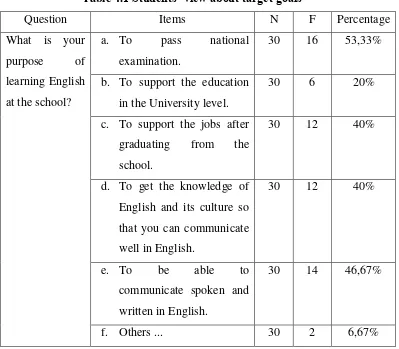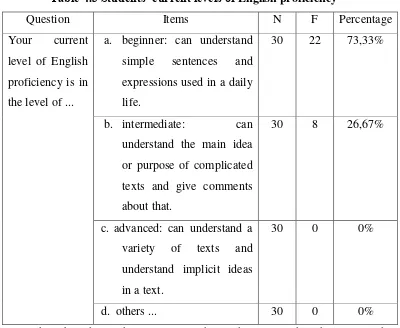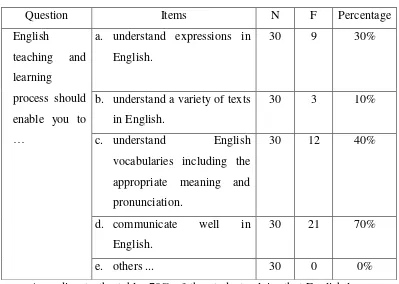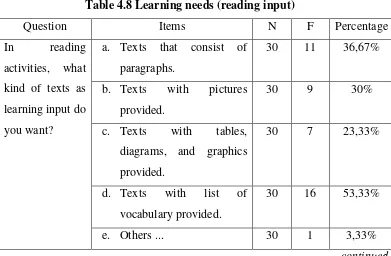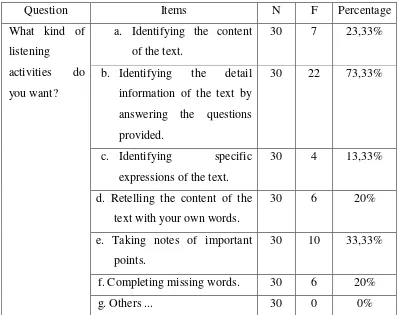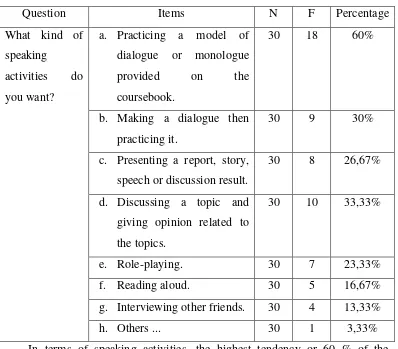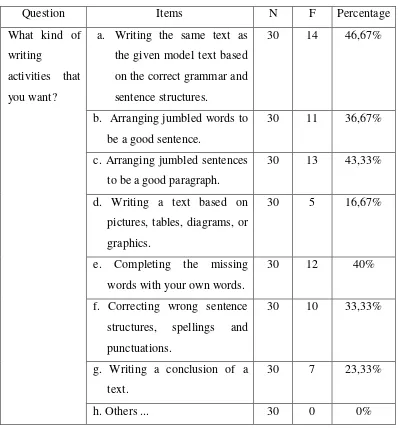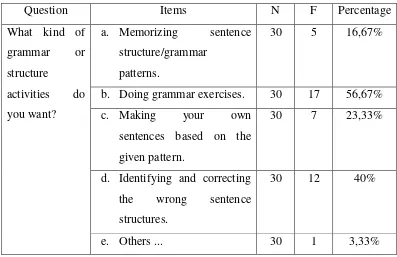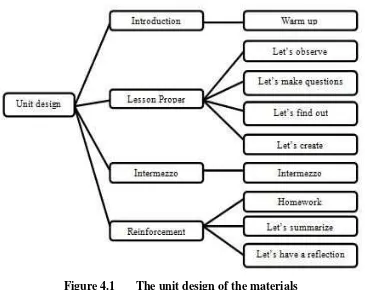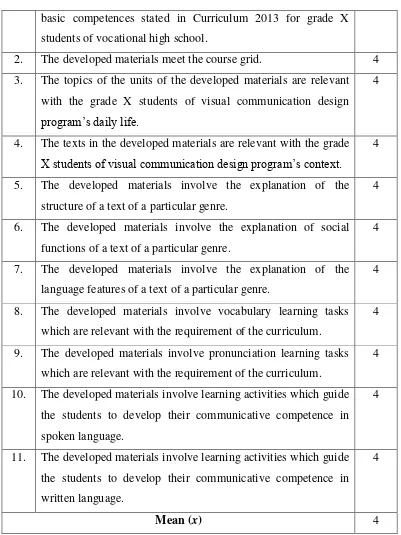i
DEVELOPING ENGLISH LEARNING MATERIALS FOR GRADE TEN STUDENTS OF VISUAL COMMUNICATION DESIGN PROGRAM OF SMK
KOPERASI YOGYAKARTA BASED ON CURRICULUM 2013
A Thesis
Presented as Partial Fulfillment of the Requirement for the Attainment of Sarjana Pendidikan Degree in English Language Education
By:
Satwika Nindya Kirana 10202241061
ENGLISH EDUCATION DEPARTMENT FACULTY OF LANGUAGES AND ARTS STATE UNIVERSITY OF YOGYAKARTA
ii
APPROVAL SHEET
DEVELOPING ENGLISH LEARNING MATERIALS FOR GRADE TEN STUDENTS OF VISUAL COMMUNICATION DESIGN PROGRAM OF SMK
KOPERASI YOGYAKARTA BASED ON CURRICULUM 2013
A Thesis
By:
Satwika Nindya Kirana 10202241061
Approved in December 8th, 2014
iii
Joko Priyana, Ph.D.NIP. 19650122 199001 1001 RATIFICATION SHEET
DEVELOPING ENGLISH LEARNING MATERIALS FOR GRADE TEN STUDENTS OF VISUAL COMMUNICATION DESIGN PROGRAM OF SMK
KOPERASI YOGYAKARTA BASED ON CURRICULUM 2013
A Thesis
Accepted by the board of examiners of English Education Department, Faculty of Languages and Arts, State University of Yogyakarta on December 2014 and declared to
have fulfilled the requirement to acquire A Sarjana Pendidikan Degree
BOARD OF EXAMINERS
Position Name Signature Date
Chairperson Samsul Maarif, M.A. ____________ ____________
Secretary Siwi Karmadi, M.Hum. ____________ ____________
First Examiner Nury Supriyanti, M.A. ____________ ____________
Second Examiner Joko Priyana, Ph.D. ____________ ____________
Yogyakarta, December 2014 Faculty of Languages and Arts State University of Yogyakarta
Dean,
iv
PERNYATAAN
Yang bertanda tangan di bawah ini, saya
Nama : Satwika Nindya Kirana
NIM : 10202241061
Prodi : Pendidikan Bahasa Inggris
Fakultas : Bahasa dan Seni
menyatakan bahwa karya ilmiah ini adalah hasil pekerjaan saya sendiri. Sepanjang pengetahuan saya, karya ilmiah ini tidak berisi materi yang ditulis orang lain, kecuali bagian-bagian tertentu yang saya ambil sebagai acuan dengan mengikuti tata cara dan etika penulisan karya ilmiah yang lazim.
Apabila ternyata terbukti bahwa pernyataan ini tidak benar, sepenuhnya menjadi tanggung jawab saya.
Yogyakarta, Desember 2014
Penulis,
v MOTTOS
“GARDENS ARE NOT MADE BY SITTING IN THE SHADE”
-Rudyard Kipling-
“KNOWLEDGE IN YOUTH IS WISDOM IN AGE”
-English Proverb-
vi
DEDICATIONS
vii
ACKNOWLEDGEMENTS
I praise Allah SWT, the Most Gracious and the Most Merciful who always gives me His great blessing, kindness, and miracle so that I could finish this thesis. Blessing may also be sent upon Prophet Muhammad SAW. During the long process of my study and finishing this thesis, there are many people who contributed to the completion. I would like to thank them all in this acknowledgement.
My first and deepest gratitude goes to my supervisor, Mr. Joko Priyana, Ph.D. for all his patience, guidance, suggestions, motivations, and encouragement during the process of writing this thesis. I would also like to express my gratitude to Mr. Ari Purnawan, M.A. for his kindness to validate my materials through expert judgment process. My huge thanks are also due to all lecturers of English Language Education Department who taught me.
I would also like to thank my beloved and special friends of English Education 2010 UNY who gave me support to finish this thesis: Ahong, Fitri, Nunu, Erlin, Aulia, Tyas, Dita, Tika, Iden, Hars, Bayu, Isa, Pak Soleh, Banat, Winda, Tiara, and many others. I also would like to thank my lovely Mexican friend, Beatriz, who helped me correct my grammar. A special thank is addressed to my super parents and family in Tegal for all their supports, motivations, and loves.
viii
program, Mr. Aris, and grade X students of SMK Koperasi Yogyakarta for their cooperation so that I could conduct my needs analysis. I hope this thesis is useful for teachers and students of Visual Communication Design program of SM Koperasi Yogyakarta and other material developers. I realize that this thesis is not perfect. Therefore, suggestions for improvement of this thesis are highly appreciated.
Thank you.
Yogyakarta, December 2014 The Researcher,
ix
LIST OF APPENDICES APPENDIX A. The needs analysis instruments
APPENDIX B. The needs analysis data APPENDIX C. Course grid
APPENDIX D. The description of the developed materials APPENDIX E. The first draft of the materials
APPENDIX F. The expert judgment questionnaire APPENDIX G. The expert judgment data
APPENDIX H. Revisions of the units
x
LIST OF TABLES Table 2.1. The graduate standard competences
Table 3.1. Organization of the first questionnaire for needs analysis Table 3.2. Data conversion table
Table 4.1. Students’ view about target goals
Table 4.2. Students’ view about the demands of the target situation Table 4.3. Students’ current levels of English proficiency
Table 4.4. Students’ general wants in learning English
Table 4.5. Students’ view about topics they want to learn in learning English Table 4.6. Learning needs (listening input)
Table 4.7. Learning needs (speaking input) Table 4.8. Learning needs (reading input) Table 4.9. Learning needs (writing input) Table 4.10. Learning needs (listening activities) Table 4.11. Learning needs (speaking activities) Table 4.12. Learning needs (reading activities) Table 4.13. Learning needs (writing activities) Table 4.14. Learning needs (vocabularies activities) Table 4.15. Learning needs (grammar activities) Table 4.16. Learning needs (pronunciation activities) Table 4.16. Setting
Table 4.17. Learners’ role Table 4.18. Teacher’s role
xi
xii
LIST OF FIGURES
xiii
TABLE OF CONTENTS
TITLE PAGE ... i
APPROVAL SHEET ... ii
RATIFICATION SHEET ... iii
PERNYATAAN ... iv
MOTTOS ... v
DEDICATIONS ... vi
ACKNOWLEDGEMENTS ... vii
LIST OF APPENDICES ... ix
LIST OF TABLES ... x
LIST OF FIGURES ... xii
TABLE OF CONTENTS ... xiii
ABSTRACT ... xvi
CHAPTER I: INTRODUCTION A. Background of the Study ... 1
B. Identification of the Problems ... 3
C. Limitation of the Problems ... 3
D. Formulation of the Problems ... 4
E. Objectives of the Study ... 4
F. Significance of the Study ... 4
xiv
2. English for VHS Based on Curriculum 2013 ... 7
3. English for Specific Purposes (ESP) ... 10
a. The Nature of ESP ... 10
b. Theory of ESP ... 11
c. The Categories of ESP ... 12
4. Needs Analysis ... 13
5. Materials Design ... 14
a. The Principles in Designing Materials ... 14
b. The Evaluation of Designing Materials ... 15
c. The Model of Materials Design ... 16
6. Grading and Sequencing Tasks ... 20
B. Conceptual Framework ... 21
CHAPTER III: RESEARCH METHOD A. Type of the Research ... 23
B. Population and Sample of the Research ... 23
C. Setting of the Research ... 23
D. Data Collection Technique and Instrument ... 24
E. Data Analysis Technique ... 26
F. Procedure of the Research ... 28
CHAPTER IV: FINDINGS AND DISCUSSION A. Research Findings 1. The Result of the Needs Analysis ... 31
xv
3. The Unit Design ... 50
4. The First Draft of the Materials ... 52
5. The Expert Judgment ... 55
B. Discussion ... 73
CHAPTER V: CONCLUSIONS AND SUGGESTIONS A. Conclusions ... 80
B. Suggestions ... 84
REFERENCES ... 86
xvi
DEVELOPING ENGLISH LEARNING MATERIALS FOR GRADE TEN STUDENTS OF VISUAL COMMUNICATION DESIGN PROGRAM OF SMK
KOPERASI YOGYAKARTA BASED ON CURRICULUM 2013 By: develop appropriate learning materials for grade ten students of Visual Communication Design program of SMK Koperasi Yogyakarta.
This study is a Research and Development (R&D) study. The subjects of this study were grade ten students of Visual Communication Design program of SMK Koperasi Yogyakarta. This study adapted the R&D model proposed by Borg and Gall (1983) and Masuhara (in Tomlinson, 1998). The steps of this study were conducting needs analysis, developing the course grid, developing the first draft of the materials, evaluating the materials, and writing the final draft of the materials. Two types of questionnaire were used to collect data. The first questionnaire was made to obtain the data for the needs analysis while the second questionnaire was used to obtain the data about the appropriateness of the materials through the expert judgment. The data of both questionnaires were analyzed quantitatively through descriptive statistics.
1 CHAPTER I
INTRODUCTION
This chapter is divided into six subheadings that explain the background of
the study, identification of the problems, limitation of the problem, formulation of
the problems, objectives of the study, and significance of the study.
A. Background of the Study
There are many vocational high schools in Indonesia, and the government
also supports the development of the vocational high schools themselves since
they hopefully help the government to decrease the number of unemployment
people in Indonesia. There are numerous vocational programs, i.e. visual
communication design, accounting, marketing, management, and many more. One
of the vocational programs is Visual Communication Design program that
becomes a favorite study program in this global era. Since the purpose of
vocational high school is to generate ready-to-work graduates, the schools must
equip the students with English as a prerequisite skill to enter labor market.
Materials are one of the important elements in the English teaching and
learning process. However, it is difficult to find a coursebook for vocational high
schools, especially coursebooks that focus on a particular vocational program
only. Most coursebooks for vocational high schools are the combination of
materials for some main programs such as accounting, marketing, secretary, etc..
That fact makes the teachers find it difficult to adopt the materials since those are
2
Design program that is categorized as a new vocational program, it is difficult to
find a coursebook that focuses on their context and their needs.
This phenomenon requires the teachers to design the materials themselves.
However, they are lack of time and ability. Teachers are too busy in teaching the
students and doing school administrative activities. Most of the teachers are also
not able to design the materials since they were not taught how to design materials
when they were in the university.
Another problem is the change of curriculum, from KTSP or Curriculum
2006 to Curriculum 2013. This change of curriculum requires the change of the
coursebooks. The coursebooks designed to every level of education in Indonesia
must be changed since there are some differences between Curriculum 2006 and
Curriculum 2013. For vocational high schools, especially Visual Communication
Design program, the coursebook that is based on Curriculum 2013 is not available
yet. In reference to the above problems, English learning materials for grade ten
students of Visual Communication Design program of SMK Koperasi Yogyakarta
should be designed.
B. Identification of the Problems
One of the important factors in language teaching and learning process is
materials which are used as the input and exposures. The materials must be
designed based on the students’ needs. The first problem that was identified is the
difficulty to find materials that focus on and relevant to vocational high school
been appearing since the previous curriculums. It appears because there are many
programs of vocational high schools that have different needs in learning English,
but most coursebooks for vocational high school are provided for more than just
one program, and sometimes are not relevant to the students’ needs.
In formal educations, the students’ needs are determined by the
curriculum. With the change of curriculum, from KTSP to curriculum 2013, the
materials should be changed too. Moreover, there are some differences between
Curriculum KTSP and Curriculum 2013. It leads to another problem that is the
students’ books, especially those for Visual Communication Design program that
are based on Curriculum 2013 are unavailable yet. The students books, whether
for regular classes or enrichment, are needed by all levels of visual
communication design program that is grade X, XI, XII. However, the students’
books are not available yet.
C. Limitation of the Problems
In reference to the problems above, this study deals with developing
English learning materials for regular classes for grade ten students of Visual
Communication Design program of SMK Koperasi Yogyakarta based on
Curriculum 2013.
D. Formulation of the Problems
This research has formulated the problems as follow:
1. What are the target needs of grade ten students of Visual Communication
4
2. What are the learning needs of grade ten students of Visual Communication
Design program of SMK Koperasi Yogyakarta?
3. What are the appropriate learning materials for grade ten students of Visual
Communication Design program of SMK Koperasi Yogyakarta?
E. Objectives of the Study
The study has some objectives that cope with learners and English
materials. Those objectives are:
1. To describe the target needs of grade ten students of Visual Communication
Design program of SMK Koperasi Yogyakarta.
2. To describe the learning needs of grade ten students of Visual
Communication Design program of SMK Koperasi Yogyakarta.
3. To develop appropriate learning materials for grade ten students of Visual
Communication Design program of SMK Koperasi Yogyakarta.
F. Significance of the Study
The study is expected to give significant contribution theoretically and
practically for:
1. The students of Visual Communication Design program of SMK Koperasi
Yogyakarta
The results of this research are aimed at providing useful inputs for students
to have more practice in using their language skills.
The results of this research are expected to be one of the resources to inspire
teachers of vocational high schools in developing appropriate materials for
their students in order to improve their English teaching and learning process.
3. Course designers of materials developers
The results of this research are of great use for course designers or materials
developers in developing specific materials that meet students’ needs. 4. Other researchers
The results of this research can be used as a reference for other researchers to
6 CHAPTER II
LITERATURE REVIEW AND CONCEPTUAL FRAMEWORK
This chapter presents the literature review and the conceptual framework of the research. In the literature review, some theories underlying the research are examined by the researcher. In the conceptual framework, the researcher relates the literature review to the research.
A. Literature Review
1. Teaching English for Vocational High Schools
Teaching English for vocational high schools is different from teaching English for senior high schools because the purposes are different. In vocational high schools, English must be based on the students’ needs and must be relevant to their field of study (Zhang, 2008).
According to National Education Department (2006), English is an adoptive subject, in which it is aimed to provide students the ability to communicate in English in the communicative materials contexts needed for the students’ program, both written and spoken.
It can be concluded that in teaching English for vocational high schools, the teachers must consider the students’ program and field of study. This can be
2. English for Vocational High Schools Based on Curriculum 2013
According to the Indonesian Education Act No. 20 Year 2003 about National Education System, curriculum refers to a set of plan and regulation about the goals, contents, and materials and also the methods applied as the guidelines of the implementation of teaching and learning process to achieve particular education objectives. According to the definition, there are two dimensions of curriculum, the first is the plan and regulation of the goals, contents, and materials, the second is the method applied for the teaching and learning process. Government, especially Minister of Education and Culture believes that Curriculum 2013 meets those dimensions.
Indonesian curriculum has changed several times. It is changed in line with the needs of students, the methods, the technology and the changes in the current life, so that it will be relevant to the current condition (Mulyasa, 2013).
8
Curriculum 2013 emphasizes on character education. The graduate standard competences (SKL) of curriculum 2013 are categorized into three aspects, those are attitude, knowledge and skills. The graduate standard competences of vocational high school students are presented below.
Table 2.1 The Graduate Standard Competences
Attitude
Have the attitude that reflects religious, good, educated, and responsible person in interacting effectively with the social and natural environment and can put him or herself as the representative of the nation in the universal society.
Knowledge
Have the factual, conceptual, procedural and metacognitive knowledge in the field of science, technology, art and culture with humanity, nationality, and civilization knowledge related to the cause and effect of phenomena and events.
Skill
Have the ability of thinking and behaving that is effective and creative in the sense of abstract and concrete as the development of what learned in the school individually.
In Curriculum 2013 there is no novice, elementary and intermediate level in the standard competence. The curriculum for vocational high schools is similar with the one for senior high schools.
According to the Regulation of Minister of Education and Culture Number 70 Year 2013, the basic competences for grade X students of vocational high school contain some:
A. Language functions:
1. self-introduction, 2. complimenting, 3. caring,
4. intention to do something,
5. asking and stating about past events B. Texts:
1. descriptive texts related to person, tourism object, and historical building,
2. recount texts about experience and events,
3. narrative texts in the form of legend; a short functional text in the form of announcement.
10
3. English for Specific Purposes (ESP)
a) The Nature of ESP
Teaching English in vocational high schools is categorized into English for Specific Purposes (ESP) because the materials are specific to a certain area and based on the students’ needs. What is ESP actually? Hutchinson and Waters (1987) stated indirectly in their book ‘English for Specific Purposes’ that ESP is
an approach of language teaching in which the designing of the content and deciding the method is based on the learners’ needs. From the definition above, it is clear that the root of ESP is the learners’ needs because their needs are specific
in a certain area, not only general English that is taught in other formal school levels.
There are three reasons of why ESP is emerged as mentioned by Hutchinson and Waters (1987: 6-8):
1. The demands of a brave new world
The end of Second World War in 1945 created a new world which was dominated by two forces: technology and commerce. Those forces caused there were many people who want to learn English, not for pleasure or prestige of knowing the language, but because English was the key to International technology and commerce.
2. A revolution in linguistics
away from defining the formal features of language usage to discovering the ways in which language is actually used for communication in real life. 3. Focus on the learners
A new development in educational psychology is emphasizing the central importance on learners and their attitudes. That means that the language learning should be based on learners’ needs and interests.
b) Theory of ESP
There are some theories related to the English for specific purposes. Richards (1988) states that in circumstances where English is taught for specific and narrowly defined purposes rather than for a more general communicative goal, the content of language cannot longer be identified with the same grammar, vocabulary, notions, topics and functions that serve the needs of English for general purposes. It means that the content of ESP is different from the content of general English.
12
Further theory about ESP course is proposed by Robinson (1991). He says that ESP is a goal-directed course and it is developed from needs analysis which aims to specify as closely as possible what exactly it is that students have to do through the medium of English.
c) The Categories of ESP
According to Hutchinson and Waters (1987), ESP can be classified based on the general nature of learners’ purpose and specific needs or specialties.
Based on the learners’ purpose, there are: 1. English for Academic Purposes (EAP)
As the name suggests, this type of ESP helps the learners require English for academic study.
2. English for Occupational Purposes (EOP)
In contrast with EAP, EOP focuses on work purposes. It is also usually called EVP (English for Vocational Purposes) or VESL (Vocational English as a Second Language).
Based on the learners’ specific needs there are:
1. English for Science and Technology (EST); 2. English for Business and Economics (EBE); 3. English for Social Science (ESS).
4. Needs Analysis
What distinguishes ESP from General English is the awareness of the needs. In ESP, the materials are developed based on learners’ needs. That means that we should conduct needs analysis. Needs analysis can be simply defined as the process of analyzing the learners’ needs.
Graves (2000) explains much about needs analysis. He says that the process of needs analysis involves a set of decisions, actions, and reflections that are cyclical in nature:
1. Deciding what information to gather and why.
2. Deciding the best way to gather it: when, how, and from whom. 3. Gathering the information.
4. Interpreting the information. 5. Acting on the information.
6. Evaluating the effect and effectiveness of the action. 7. Deciding on further or new information to gather.
For a course to meet learners’ needs it is necessary to gather information
about both the current state of the learners, where they stand in terms of language ability, learning preferences, and the desired goals or change, and where they would like to be or what they want to achieve, change, and so on (Graves, 2000).
The following are types of information that can be gathered when analysing needs as suggested by Graves (2000):
The present
14
2. the learners’ level of language proficiency; 3. the learners’ level of intercultural competence; 4. their interests;
5. their learning preferences; 6. their attitudes.
The future
7. the learners’ goals and expectations;
8. the target contexts: situations, roles, topics, and content;
9. types of communicative skills they will need and tasks they will perform;
10.language modalities they will use.
Hutchinson and Waters (1987) propose a number of ways that are most frequently used in analysing needs, namely questionnaires, interviews, observations, and data collections.
According to the theories above, the researcher used questionnaires to gather the target needs and learning needs of grade ten students of Visual Communication Design program.
5. Materials Design
a. The Principles in Designing Materials
3. Materials should stimulate interaction.
Students’ interaction promotes language learning in several ways,
including:
a) providing greater opportunity for students to use language; b) creating a less stressful environment for language use;
c) allowing students to use a greater range of language functions; d) encouraging students to help one another;
e) increasing motivation to learn.
4. Materials should allow learners to focus on formal aspects of the language 5. Materials should encourage learners to develop learning skills
Nunan (1988) identifies five key aims of instruction which help students acquire language learning skill:
a) to provide learners with efficient learning strategies;
b) to assist learners to identify their own preferred ways of learning; c) to develop skills needed to negotiate the curriculum;
d) to encourage learners to set their own objectives; e) to develop learners skills in self-evaluation.
6. Materials should encourage learners to apply their developing language skills to the world beyond the classroom
b. The Evaluation of Designing Materials
Hall (1995) proposes criteria by which the materials might be evaluated: 1. The needs to communicate
16
a) must have something to communicate; b) someone to communicate with;
c) some interests in the outcome of the communication. 2. The needs for long-term goals
The materials should provide students with the ability to: a) initiate the communication events;
b) persist with the attempted communication even when it becomes difficult.
3. The needs for authenticity
a) authenticity response depends on the existence of the authentic needs; b) authentic response dictates the addressing of contents rather than
forms;
c) authentic discussion for clarification or expansion rather than for the mere checking of understanding.
4. The needs for students centeredness
c. The Model of Materials Design
Hutchinson and Waters (1987) states that the model of materials design consists of four elements: input, content focus, language focus, and task. a) Input
Stimulus materials for activities;
New language items;
Correct models of language use;
A topic for communication;
Opportunities for learners to use their information processing
skills;
Opportunities for learners to use their existing knowledge both of
the language and the subject matter. b) Content focus
Language is not an end by itself, but a means of conveying information and feelings about something. Non-linguistic content should be exploited to generate meaningful communication in the classroom. c) Language focus
Good materials should involve both opportunities for analysis and synthesis. In language focus, learners have chance to take the language to pieces, study how it works, and practice putting it back together again.
d) Task
18
Further, Nunan (2004) says that a task consists of six components: goals, input, procedure, teacher’s roles, and learners’ roles.
1) Goals
Task goal is the general intention or aims behind any learning task. It provides a link between the task and the curriculum. There are four types of task goal:
Communicative
Socio-cultural
Learning-how-to-learn
Language and cultural awareness
2) Input
Input is the spoken, written, and visual data that learners work within the course of completing a task. There are five types of input:
Genuine: created only for the realm of real life, not for the
classroom, but used in the classroom for language teaching.
Altered: While there is no meaning change, the original has been
altered in other ways (for example, the insertion of glosses, visual resetting, the addition of visuals).
Adapted: Although created for real life, vocabulary and
grammatical structures are changed to simplify the text.
Simulated: Although specially written by the author for purposes
Minimal / incidental: Created for the classroom with no attempt to
make the material appear genuine. 3) Procedure
Task procedure is what to do for achieving and processing the input. The characteristics of effective procedure are:
developed for the output;
rehearse the real-world task; relevant to the objectives.
4) Teacher’s roles
‘Role’ refers to the part that learners and teachers are expected to play in
carrying out learning tasks as well as the social and interpersonal relationships between the participants. There are some roles of teachers in a task. The teachers can be assistants, developers, facilitators, observers, and controllers.
5) Learners’ roles
Learners’ roles in a task are includes:
the learner is a passive recipient of outside stimuli
the learner is an interactor and negotiator who is capable of giving as well
as taking
the learner is a listener and performer who has little control over the
content of learning
20
the learner is involved in a social activity, and the social and interpersonal
roles of the learner cannot be divorced from psychological learning processes
the learner must take responsibility for his or her own learning, develop
autonomy and skills in learning-how-to-learn. 6) Settings
Settings refer to the classroom arrangements specified or implied in the task. It also requires consideration of whether the task is to be carried out wholly or partly outside the classroom.
According to those theories, Nunan’s theory of six components of tasks will be adapted by the researcher to develop English materials for the grade X students of SMK Koperasi Yogyakarta.
6. Grading and Sequencing Tasks
Tasks must be graded and sequenced from the easy one to the difficult one. In reading and listening skills, input becomes an important part that must be sequenced. Grammatical factors influence the complexity of the input. The difficulty will be affected by the length of a text, propositional density, the amount of low-frequency vocabulary, the speed of spoken text and the number of speakers involved, the explicitness of the information, the discourse structure and the clarity with which it signaled (Nunan, 2004). In addition, the same input can be used for more than one task with different level of task difficulty. It can be done by adjusting the procedural demands on the learners.
Tasks must also be sequenced from the less demanding to the more demanding, moving from comprehension-based procedures to controlled production activities and exercises, and finally to ones requiring authentic communicative interaction (Nunan, 2004).
B. Conceptual Framework
22
There are some factors that need to be considered in developing English materials for Visual Communication Design program,
English for Vocational High Schools is categorized as English for Specific Purposes (ESP) since it focuses on a specific field. The first step of ESP is conducting needs analysis. In this research, the needs analysis is conducted through questionnaire. The questionnaire analyzes the students target needs and learning needs.
The materials which are developed in the form of students’ book consist of
some units. The units are built around themes that support goals or objectives of the study. A unit consists of several tasks that enable the students to achieve the goal. The tasks are sequenced from the easiest to the hardest one and from receptive to productive activities. The tasks also applied scientific approach that consists of six steps; observing, questioning, collecting data, analyzing data, communicating, and creating.
The last factor needs to be considered in developing the materials is material evaluation. In this study, the expert of materials will be asked to give a judgment which includes the measurement of the appropriateness of the content, the language, the presentation, and the graphic.
23
CHAPTER III
RESEARCH METHOD
This chapter describes the method of the research. The description is
organized into six subheadings: type of the research; population and sample of the
research; setting of the research; data collection technique and instrument; data
analysis technique; and procedure of the research.
A. Type of the Research
The study is categorized as Research and Development (R&D) since the
aim and result of the research is to develop a product (i.e., a set of materials) that
can be used in an educational program.
B. Population and Sample
In conducting the study, two different population were taken by the
researcher in which the samples were taken randomly.
a. Grade ten students of Visual Communication Design program of SMK
Koperasi Yogyakarta. The first sample was labeled as subject.
b. An English lecturer in English Education Department of Yogyakarta State
University. The second sample was labeled as evaluator.
C. Setting of the Research
The research took place in SMK Koperasi Yogyakarta that is located at
Jalan Kapas 5 Yogyakarta. It has three study programs, those are accounting,
marketing, and visual communication design program. There are three classes of
24
design program since it is a new study program. The observation was held on June
2014.
D. Data Collection Technique and Instrument
In this study, two questionnaires were used by the researcher to collect
data. The first questionnaire aimed to assess the learners’ needs, thus, this
questionnaire was applied to subject. The second questionnaire aimed to evaluate
designed materials and to find out if the materials are already suitable with the
learners’ needs or not, therefore, this questionnaire was applied to evaluator.
In the first questionnaire, the subject was asked several questions related to
their learning needs by answering multiple choice questions. This questionnaire
was given to collect learners’ needs. The organization of the first questionnaire is
presented on the table below.
Table 3.1 Organization of the first questionnaire for needs analysis
Aspects Item Number The Purpose of the
Questionnaire
References
Learners’ Identities
Section I To find out who the students are Graves
(2000: 103)
Hutchinson
and Waters
(1987: 63) Learners’
goal
1 To find out the learners’goal in
learning English
Graves
(2000: 104)
continued
Necessities 2,3 To find out what the students
need in the target situation for
their job in the future.
To find out what the students
need in the target situation for
their job as students.
Hutchinson
what they should know
Hutchinson
included in the materials
Nunan (2004:
Setting 22, 23 To find out in what situations the
learning process will take place
Nunan (2004:
26
they were Strongly Agree (SA), Agree (A), Disagree (D), or Strongly Disagree
(SD). The questions of this questionnaire were derived from Instruments of
Evaluation of English Coursebooks for Vocational High School. The questions
are divided into four parts, those are the appropriateness of content, the
appropriateness of language, the appropriateness of presentation, and the
appropriateness of graphic.
E. Data Analysis Technique
The data from the needs analysis and the expert judgment questionnaires
were analyzed quantitatively through descriptive statistics. The data from the
needs analysis questionnaire were analyzed by calculating the percentage of each
answer in the questionnaire. The answer of which the percentage was the highest
was considered representing students’ actual condition. The percentage was
calculated using the following formula.
P : percentage (%)
f : frequency
N : number of respondents
100 : fixed number
In the second questionnaire, the response categories were weighted by
numbers, SA= 4, A= 3, D= 2, SD= 1. The data from this questionnaire were first
R : range
Xh : the highest scale
Xl : the lowest scale
4 : range of Likert-scale
Then, the result of the calculation was converted into descriptive analysis.
To convert the data, data conversion table proposed by Suharto (2005) was used
as the mean of the data had been calculated.
Table 3.2 Data conversion table
Scale Interval Descriptive Categories
1 1 ≤ � ≤ 1.74 Poor
2 1.74 ≤ � ≤ 2.24 Fair
3 2.25 ≤ � ≤ 3.24 Good
4 3.25 ≤ � ≤ 4 Very Good
x is mean obtained from expert judgment. To find x, the following formula
proposed by Suharto (2005) is used.
R = �ℎ − ��4
28
F. Procedure of the Research
The research procedure used in this study modifies the steps of R&D cycle
proposed by Borg and Gall (1983) and the steps of course design proposed by
Masuhara (in Tomlinson, 1998). Borg and Gall (1983) propose ten steps of R&D
cycle as follows:
1. Research and information collecting
2. Planning
3. Developing preliminary form of product
4. Preliminary field testing
5. Main product revision
6. Main field testing
7. Operational product revision
8. Operational field testing
9. Final product revision
10.Dissemination and implementation
Further Masuhara (in Tomlinson, 1998) offers five steps of course design:
1. Needs analysis
2. Goals and objectives
3. Syllabus design
4. Methodology or materials
5. Testing and evaluation
According to the two models of R&D cycles, the researcher modified and
Figure 3.1 The model of materials development of the research
1. Collecting the information
This step covered preliminary observation, literature review, and needs
analysis.
2. Planning
It included analyzing the information of data collected and planning the
materials.
3. Designing the first draft of the materials
This step included writing the course grid and developing the preliminary
or the first draft of the materials.
4. Conducting evaluation
This step included conducting evaluation and revision of the first draft of
the materials. collecting the
information
Designing the first draft of the materials planning
conducting evaluation revising and writing the
30
5. Revising and writing the final draft of the materials
The developed materials were revised based on the recommendations that
were derived from the second questionnaire. Then, after revising the
31
This chapter presents the findings and discussion of the research. It
provides the description of the research findings and discussion. The research
findings consist of the result of the need analysis, the course grid, the first draft of
the materials, the expert judgment, and the final draft of the materials.
A. Research Findings
1. The Result of Needs Analysis
A need analysis was conducted as the first stage of the research to assess
the target and learning needs of the students. The questionnaire was distributed in
19th June 2014. The questionnaire was in the form of multiple choices questions.
There were some questions in which the students were only allowed to choose one
option, and there were some questions in which the students were allowed to
choose more than one option. The highest percentage was considered as the
students needs.
a. Target needs
According to Hutchinson and Waters (1987), a target need is learners’
view about the target situation. The analysis of the target needs is divided into
32
a) Necessities
Necessities are the type of needs determined by the demands of the target
situation. The following tables show Visual Communication Design students’
view about the target goals and the demand of their target situation.
Table 4.1 Students’ view about target goals
Question Items N F Percentage
in the University level.
30 6 20%
communicate spoken and
written in English.
30 14 46,67%
f. Others ... 30 2 6,67%
In terms of goal the students want to reach in learning English, from the
result above it can be seen that 53.33 % of the respondents learn English to pass
Table 4.2 Students’ view about the demands of the target situation
a. beginner: can understand
simple sentences and
expressions used in a daily
life.
30 8 26,67%
b. intermediate: can
understand the main idea
or purpose of complicated
texts and give comments
about that.
30 18 60%
c. advanced: can understand
a variety of texts and
understand implicit ideas
in a text.
a. beginner: can understand
simple sentences and
expressions used in a daily
life.
30 3 10%
b. intermediate: can
understand the main idea
or purpose of complicated
texts and give comments
about that.
30 6 20%
c. advanced: can understand
a variety of texts and
understand implicit ideas
in a text.
30 20 66,67%
34
In terms of the demand of target situation, the above table shows that 60%
of the students believe that they need to be in intermediate level in order to
support their job now as students, and 66,67% of the students claim that they need
to be in advance level in order to support their later education and job.
b) Lacks
Lacks is the gap between what the learners know already and what the
learners do not know. The students’ views about their lacks are shown in the
following tables.
Table 4.3 Students’ current levels of English proficiency
Question Items N F Percentage
Your current
level of English
proficiency is in
the level of ...
a. beginner: can understand
simple sentences and
expressions used in a daily
life.
30 22 73,33%
b. intermediate: can
understand the main idea
understand implicit ideas
in a text.
30 0 0%
d. others ... 30 0 0%
The table shows that 73,33% of the students state that they are in the
c) Wants
Wants is what the learners expect about language area that they want to
master. The following tables show students’ general wants in learning English.
Table 4.4 Students’ general wants in learning English
Question Items N F Percentage
a. understand expressions in
English.
30 9 30%
b. understand a variety of texts
in English.
30 3 10%
c. understand English
vocabularies including the
appropriate meaning and
pronunciation.
teaching and learning process should make them communicate well in English.
Table 4.5 Students’ view about topics they want to learn in learning English
Question Items N F Percentage
What kind of
topics or themes
that you want?
a. Topics related to daily life
in family, school, and
society.
30 21 70%
36
continued
b. Topics related to teenagers’ life.
30 9 30%
c. Topics related to politics,
economics, and
socio-cultural life.
30 3 10%
d. Topics related to science (for
examples: plants, planets,
universe, new invention in
science and technology).
30 4 13,33%
e. Topics related to your future
job on visual communication
design.
30 19 63,33%
f. Others ... 30 1 3,33%
In terms of topics or theme, according to the result above, 70% of the
students choose topics related to daily life in family, school, and society.
b. Learning needs
Learning needs are different from target needs. Hutchinson and Waters
(1987) state that learning needs refer to what the learners need to do in order to
learn. Learning needs are represented through seven components of task (Nunan,
2004). The analysis of learning needs of the students is divided into some points
that are input, procedures, learners’ role, teacher’s role, and setting as seen from
a) Input
Input refers to the spoken, written and visual data that learners work with
in the course of completing a task. The students’ view about the input that should
be carried out in the designed task is shown in the following tables.
Table 4.6 Learning needs (listening input)
Question Items N F Percentage
a. Monologues and dialogues
without pictures.
30 1 3,33%
b. Monologues and dialogues
with pictures.
30 18 60%
c. Monologue and dialogue
with new vocabulary
According to the result above it can be seen that 60% of respondents think
that the appropriate materials for listening activities are monologues and dialogues
with pictures and in terms of the length of listening input, 46,67% of the students
38
Table 4.7 Learning needs (speaking input)
Question Items N F Percentage
a. Monologues and dialogues
without pictures.
30 11 36,67%
b. Monologues and dialogues
with pictures provided.
monologues and dialogues in intermediate number of words with new vocabulary
provided.
Table 4.8 Learning needs (reading input)
Question Items N F Percentage
diagrams, and graphics
continued
From the table above, it can be seen that 53,33% or more than half of the
students chose text with list of vocabulary provided as the reading input. The
length of the text that they can understand is more than 150-200 words.
Table 4.9 Learning needs (writing input)
Question Items N F Percentage
b. New vocabulary related to
the text including the
d. Pictures, tables, diagrams, or
40
In terms of writing activities, half of the students like to have the example
of text model that will be learnt or written in writing activities as the input with
intermediate number of words.
b) Procedures
Procedures specify what learners will actually do with the input that forms
the point of departure for the learning tasks. The following tables show the
students’ view about the procedures of what they should do with the tasks.
Table 4.10 Learning needs (listening activities)
Question Items N F Percentage
What kind of
listening
activities do
you want?
a. Identifying the content
of the text.
30 7 23,33%
b. Identifying the detail
information of the text by
answering the questions
provided.
30 22 73,33%
c. Identifying specific
expressions of the text.
30 4 13,33%
d. Retelling the content of the
text with your own words.
30 6 20%
listening by identifying detail information of the text by answering the questions
Table 4.11 Learning needs (speaking activities)
dialogue or monologue
provided on the
speech or discussion result.
30 8 26,67%
monologue provided in the coursebook.
Table 4.12 Learning needs (reading activities)
Question Items N F Percentage
general idea of the text.
42
continued
c. Reading a text then
answering questions
related to the text.
30 14 46,67%
d. Reading aloud a text with
the correct pronunciation
and intonation.
30 9 30%
e. Arranging jumbled
paragraphs or sentences to
be good paragraphs or
sentences.
30 4 13,33%
f. Summarizing the content of
the text.
30 5 16,67%
g. Discussing the content or
the meaning of certain
expressions on the text
and the meaning or the use
of those expressions based
on the context.
30 7 23,33%
h. Others ... 30 0 0%
From the result, it can be seen that 46,67% of the respondents claim that
they want to learn reading by reading a text then answering questions related to
Table 4.13 Learning needs (writing activities)
on the correct grammar and
sentence structures.
30 14 46,67%
b. Arranging jumbled words to
be a good sentence.
30 11 36,67%
c. Arranging jumbled sentences
to be a good paragraph.
30 13 43,33%
d. Writing a text based on
pictures, tables, diagrams, or
graphics.
30 5 16,67%
e. Completing the missing
words with your own words.
30 12 40%
f. Correcting wrong sentence
structures, spellings and
punctuations.
In terms of writing activities, 46,67% of the students like to learn writing
by writing the same text as the given model text based on the correct grammar and
44
Table 4.14 Learning needs (vocabularies activities)
Question Items N F Percentage
What kind of
vocabulary
activities do
you want?
a. Finding new vocabulary on
a text and finding the
meaning on a dictionary.
30 18 60%
b. Finding new vocabulary on
a text and identifying the
meaning based on the
context.
30 15 50%
c. Completing sentences or
paragraphs with your own
knowledge.
30 2 6,67%
d. Classifying new vocabulary
on a table then finding the
g. Searching words meanings
on a dictionary.
30 11 36,67%
h. Identifying word class:
verb, noun, adjective, etc.
30 15 50%
i. Matching words with
pictures provided.
30 3 10%
j. Others ... 30 0 0%
For vocabulary activities, 60% of the respondents tend to learn vocabulary
Table 4.15 Learning needs (grammar activities)
a. Memorizing sentence
structure/grammar
d. Identifying and correcting
the wrong sentence
structures.
30 12 40%
e. Others ... 30 1 3,33%
In terms of grammar activities, doing grammar exercises is considered to
be the most frequently chosen (56,67%).
Table 4.16 Learning needs (pronunciation activities)
Question Items N F Percentage
the pronunciation from
the teacher.
30 4 13,33%
46
words with similar sounds.
30 6 20%
f. Learning to pronounce
every sentence including
the stress and intonation.
30 6 20%
g. Others ... 30 1 3,33%
For the pronunciation activities, 53,33% of the respondents wish to learn
pronunciation by pronouncing word by word.
c) Setting
Setting can be defined as the classroom arrangements specified or implied
in the task. It also requires consideration of whether the task is to be carried out
wholly or partly outside the classroom. The following table shows the students’
view about the setting of how the task should be carried out.
Table 4.16 Setting
such as on the class edges,
school garden, school hall.
30 12 40%
c. library. 30 6 20%
d. language laboratory or
practice room.
30 12 40%
continued
classroom rather than outside and more than half students (53,33%) like to learn
in a group of 3-4 people.
d) Learners’ role
Learners’ role refers to part that learners are expected to play in carrying
out learning tasks as well as the social and interpersonal relationships between
them. The following table shows students’ opinion of the role they expect to play
on the learning process.
Table 4.17 Learners’ role
every task or exercise.
30 13 43,33%
c. use your creativity in doing
the task.
30 7 23,33%
48
involved in investigation to
solve problem and do the
tasks.
30 16 53,33%
f. others … 30 0 0%
Based on the result above, it is shown that 53,33% of the students want to
do discussion and actively involved in investigation to solve problem and doing
the task.
e) Teacher’s role
Teacher’s role refers to part that teachers are expected to play in carrying
out learning tasks as well as the social and interpersonal relationships between the
participants. The following table shows students’ opinion of roles they expect the
teacher to play while they are learning.
Table 4.18 Teacher’s role
you do the exercises.
continued
d. give suggestion, correction,
and comment in every result of students’ learning.
30 11 36,67%
e. create condition for the
students to be active in
solving problems and doing
tasks.
30 13 43,33%
f. others ... 30 0 0%
The above table figures out that 43,33% of the students want the teacher to
create condition for the students to be active in solving problems and doing tasks.
2. Course Grid
The next step of material development was writing course grid. The course
grid was used as a guideline to design the units of the materials. When creating
the course grid, the researcher considered some aspects such as the result of needs
analysis, core competences, and basic competences. For the results of the need
analysis, the course grid was developed by taking the highest percentage of the
respondent. It was developed by following the core competences and basic
competences for the tenth grade of vocational high school. The course grid
consists of unit name and title, indicators, inputs, and activities.
a. Course grid of Unit 1
The course grid of Unit 1 is derived from core competences 1, 2, 3, 4, and
basic competences 1.1, 2.3, 3.9, 4.13, 4.14. The topic of this unit is experiences of
50
The title of Unit 1 is “My Art Exhibition”. The title shows that the unit focuses on
retelling experiences on attending art exhibitions. The focus of the grammar is
simple past tense and time conjunctions.
b. Course grid of Unit 2
The course grid of Unit 2 is derived from core competences 1, 2, 3, 4, and
basic competences 1.1, 2.3, 3.10, 4.15. The topic of this unit is folktales from
several countries. The unit focuses on narrative texts. The title of Unit 2 is
“Stories Around The World”. The title represents the text type that will be learnt
in the unit. The focus of the grammar is reported speeches.
c. Course grid of Unit 3
The course grid of Unit 2 is derived from core competence 1, 2, 3, 4 and
basic competence 1.1, 2.2, 3.4, 4.5. The topic of this unit is intention for final
projects. The unit focuses on asking for and expressing intentions. The title of
Unit 3 is “I am Going to Make a Masterpiece”. The title clearly shows that the
unit presents the expressions of asking for and expressing intentions. The focus of
the grammar is the use of “will” and “(be) going to”.
3. The Unit Design
After the course grid was developed, the next step was developing the
Figure 4.1 The unit design of the materials
Figure 4.1 shows that each unit of the materials has four parts:
introduction, lesson proper, intermezzo, and reinforcement. The introduction part
consists of warm up activities. The activities help students to have a schema
building of the materials that will be learnt. Besides, the students can recall their
present knowledge through the activities.
The second part of the materials is main lesson. It is divided into spoken
cycle and written cycle. Each cycle follows the steps of scientific approach that is
required by curriculum 2013. Those steps are observing, questioning, collecting,
analyzing, communicating, and creating. In the observing, students read or listen
to a text and are given chance to observe things they want to know in terms of
content, structure, language features, grammar, etc. Then, based on the items they
52
collecting data, analyzing data, and communicating are combined into finding out.
It aims to ease students in carrying out the tasks in the developed materials.
Students collect the data by doing the tasks and communicate their finding to their
classmates. The last part of main lesson is creating. In this step, students are asked
to produce a particular kind of text. The activities are developed from guided to
free activities. In the end of each cycle, there is an intermezzo that contains facts
related to visual communication design, proverbs, quotes, and other information.
The last part of the materials is reinforcement. It consists of homework,
summary, and reflection. The reinforcement part aims to give the students chances
to have more practice outside the classroom on what they have learnt in the unit
through activities in homework. While in summary, the students have a clear
picture of the text, language features, and grammar in the unit. The reflection
gives the students chances to recognize their own success and lack in learning the
materials in the unit.
4. The First Draft of the Materials
The developed materials consist of three units which are elaborated below:
a. Unit 1
Unit 1 is derived from core competences 1, 2, 3, 4 and basic competences
1.1, 2.3, 3.9, 4.13, 4.14. The topic of this unit is experiences of attending art
exhibitions. The unit focuses on recount texts about art exhibitions. The title of
experiences on attending art exhibitions. The focus of the grammar is simple past
tense and time conjunctions.
The core competences and basic competences require the students to be
able to analyze the social function, text structure, and language features of recount
texts and also to be able to produce the text in spoken and written forms. The unit
is divided into two cycles: spoken cycle and written cycle in which each cycle
consists of several tasks.
There are 30 tasks in the first unit; 2 tasks belong to warm up activities, 14
tasks belong to reading and writing activities, 13 tasks belong to listening and
speaking activities, and 1 task belongs to homework activity. The description of
each task is in Appendix D.
b. Unit 2
Unit 2 is derived from core competences 1, 2, 3, 4, and basic competences
1.1, 2.3, 3.10, 4.15. The topic of this unit is folktales from several countries. The
unit focuses on narrative texts. The title of Unit 2 is “Stories Around The World”.
The title represents the text type that will be learnt in the unit. The focus of the
grammar is reported speeches.
The core competences and basic competences require the students to be
able to analyze the social function, text structure, and language features of
narrative texts and also to be able to produce the text in spoken and written forms.
The unit is divided into two cycles: spoken cycle and written cycle in which each
54
There are 28 tasks in the second unit; 3 tasks belong to warm up activities,
13 tasks belong to reading and writing activities, 11 tasks belong to listening and
speaking activities, and 1 task belongs to homework activity. The description of
each task is in Appendix D.
c. Unit 3
The course grid of Unit 3 is derived from core competence 1, 2, 3, 4 and
basic competence 1.1, 2.2, 3.4, 4.5. The topic of this unit is intentions for final
projects. The unit focuses on asking for and expressing intentions. The title of
Unit 3 is “I Am Going To Make A Masterpiece”. The title clearly shows that the
unit presents the expressions of asking for and expressing intentions. The focus of
the grammar is the use of “will” and “(be) going to”.
The core competences and basic competences require the students to be
able to analyze the social function, text structure, and language features of asking
for and stating intentions and also be able to produce the text in spoken and
written forms that contain expressions of asking for and stating intentions The unit
is divided into two cycles: spoken cycle and written cycle in which each cycle
consists of several tasks.
There are 28 tasks in the third unit; 1 task belongs to warm up activities,
11 tasks belong to reading and writing activities, 10 tasks belong to listening and
speaking activities, and 1 task belongs to homework activity. The description of
5. The Expert Judgment
After the first draft of the materials was developed, the next step was
expert judgment. In this step, the materials were evaluated by an expert. The
expert of the developed materials was Ari Purnawan, M.A. He is a lecturer of
English Education Study Program of Yogyakarta State University who has
fourteen year-experience of teaching.
a. The Results of the Expert Judgment and Revisions of Unit 1
1) The Results of the Expert Judgment of Unit 1
In the expert judgment step, there were four aspects of the materials that
were evaluated. Those aspects were the appropriateness of the content, the
appropriateness of the language, the appropriateness of the presentation, and the
appropriateness of the graphic. The following are the results of the analysis of the
questionnaire for expert judgment of Unit 1.
a) The Appropriateness of the Content
The first aspect to be evaluated was the appropriateness of the content of
the developed materials. The following table shows the results of the analysis of
the appropriateness of the content of Unit 1.
Table 4.19 The Appropriateness of the Content of Unit 1
No. Items Score
1. The developed materials are in accordance with the core and 4
56
continued
basic competences stated in Curriculum 2013 for grade X
students of vocational high school.
2. The developed materials meet the course grid. 4
3. The topics of the units of the developed materials are relevant
with the grade X students of visual communication design program’s daily life.
4
4. The texts in the developed materials are relevant with the grade X students of visual communication design program’s context.
4
5. The developed materials involve the explanation of the
structure of a text of a particular genre.
4
6. The developed materials involve the explanation of social
functions of a text of a particular genre.
4
7. The developed materials involve the explanation of the
language features of a text of a particular genre.
4
8. The developed materials involve vocabulary learning tasks
which are relevant with the requirement of the curriculum.
4
9. The developed materials involve pronunciation learning tasks
which are relevant with the requirement of the curriculum.
4
10. The developed materials involve learning activities which guide
the students to develop their communicative competence in
spoken language.
4
11. The developed materials involve learning activities which guide
the students to develop their communicative competence in
written language.
4
Mean (x) 4
Table 4.19 shows that the mean value of the appropriateness of the content
of Unit 1 is 4. This value is in the range of 3.25 ≤ � ≤ 4 which falls into the
